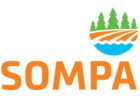There are several definitions of peatland which depend on various distinguishing factors such as vegetation cover, land use, formation characteristics, hydrology, geochemistry, for example. Different countries apply different definitions as well, hence complicating mutual comparison. According to IPCC, wetlands include any land that is covered or saturated by water for at least part of the year (and that does not fall into the Forest Land, Cropland, or Grassland categories).
Peat accumulates in wetlands when the annual production of dead organic matter exceeds the amount that decays. Therefore, peatlands could be referred as a type of wetlands. Actually, they are the most common type of wetlands globally covering around 3% of the total area majority of which is situated in the northern latitudes. Canada, Sweden, Finland, UK and Ireland have one of the highest national shares as well as Southeast Asia.
In their pristine state, peatlands provide multiple ecosystem services such as timber production, climate regulation, water quality control, flood abatement, biodiversity conservation as well as recreational benefits. Considering that the rate of plant production generally exceeds the rate of organic matter decomposition, natural peatlands also function as sinks and long-term reservoirs of carbon i.e. peat soils contain the highest concentration of organic matter in all soils. Estimations show that global peatlands store about 600 Gt of carbon.
Some sources estimate peatland area in the EU to be more than 318 000 km2, mainly in the northern latitudes. Soil organic carbon stocks in the EU-27 are estimated to be between 73 to 79 Gt of carbon, of which about 50% is located in the peatlands and forest soils of Sweden, Finland and the United Kingdom. This amount constitutes about 7% of the total global carbon storage. This contrasts with the average 1.4 Gt of carbon is emitted annually by EU Member States. The latter indicates the possible consequences should the soil carbon be released into the atmosphere.
Utilization of peatlands for forestry, agriculture and peat extraction almost always requires drainage which compromises soil carbon balance as well as other mentioned ecosystem services. The CLIMSOIL report estimated that more than 20% (65 000 km2) of all European peatlands have been drained for agriculture, 28% (almost 90 000 km2) for forestry and 0.7% (2 273 km2) for peat extraction. Drainage, or any management practices that lower the water table, changes peatlands from long-term carbon reservoirs to net sources of GHG emissions (CO2 overall, N2O at fertile sites and CH4 from ditches).
A comprehensive review of carbon and GHG fluxes from peatlands conducted at European level concluded that, when emission rates are summed as CO2 equivalents per hectare, these types of peatland are generally sources of GHGs with emission intensities increasing in order:
- Bog (ombrotrophic): forestry < mire < restoration < new drainage for forest/peat cut < peat cut < abandoned after harvest =grass < crop;
- Fen (minerotrophic): (restoration <) forestry <= mire < new drainage for forest < grass < crop.
Forestry in peatlands is most common in Northern Europe, especially in some of the Nordic countries (Finland, Sweden, Norway), Baltic countries (Estonia and Latvia) and Russia with some importance in the United Kingdom, Ireland, Canada and the United States as well. Forestry-drained peatlands in Finland cover about 4.7 Mha, 3.8 Mha in Russia, 1.4 Mha in Sweden, and 0.5 Mha in Estonia, which are 14%, 0.2%, 3% and 11% of areas of these countries..
The prevailing management regime in Scandinavia´s peatland forests is even-aged management encompassing clearcutting, soil preparation, artificial regeneration, ditch network maintenance and pre-commercial thinning. This principle was mainly economically motivated so to provide woody biomass. Continuous cover forestry (CCF) has been suggested as an alternative to clearcutting. CCF can be broadly defined as all management options which do not aim for an even-aged stand structure, are based on natural regeneration, and retain a significant proportion of the tree stand after harvesting. Despite the increasing interest, the effects of CCF on the carbon balance of the stand, and what would be the net climate benefits from management regime change have remained undocumented. In addition to the possible climate change mitigation potential, CCF and uneven-aged forests, in general, may have lower vulnerability to climate hazards.
In general it can be concluded that dedicated research in this regard is scarce, especially with regards to soil carbon balance, and the existing ones show diverse results.
Considering that certain peatland forests are reaching their harvest period, the value of peatlands´ ecosystem services other than timber production needs further studying including the aspect of carbon accounting increasing complexity, peatlands’ vulnerability to future climate risks, peat bog restoration effects, associated costs etc.
